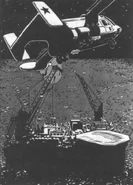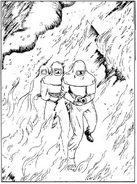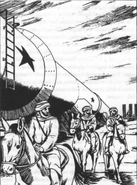Soviet World Oil Industries is a petrochemical corporation headquartered in the Soviet Union, best known in the USSR by the Russian language acronym SGKP and contraction KeroSov, and in the West by the English version of the same contraction, SovOil.[1]
SovOil, being the richest company in the Soviet Union, used its economic power to manipulate and ultimately control the Soviet government.[2][3]
History[]
1994 - 2008[]
In 1994, the Union of Soviet Socialist Republics was succeeded by the Union of Sovereign Soviet Republics, an entirely new entity based on economic cooperation. Then in 1996, the president of the Soviet Federation, Andrei Gorborev, re-structured the centrally-controlled Soviet oil industry. Soviet republics were arguing over how much control to hand over to the Central Committee of the Soviet Union, and no progress was being made.
In order to facilitate the restructuring, Gorborev named Anatoly Novikovo as the Director of the State Oil Industries Subcommittee. Novikovo, a Siberian delegate to the Central Committee, represented a large oil-producing region. One of the first things Novikovo did to ensure success was promoting Yarno Kurgasyn, a delegate from another large oil-producing region (Kazakhstan) to be his deputy director. With two representatives of large oil-producing regions heading the subcommittee, the committee would eventually be able to successfully push for a consolidated Soviet oil industry, where all of the oil production in the USSR could be controlled by a single corporation - Soviet State Oil Industries.[2]
By 1997, the Neo-Soviets had the capacity to recover only a fraction of the vast fields of oil lying under their federation. After a massive program of expansion and modernization, KeroSov, the previous state-run oil industry, became strong enough to break away from the oligarchs of the Federal Central Committee and become the Neo-Sovetskiy Neftyanoy Kombinat (Neo-Soviet Oil Combine or SovOil). Now sitting on top of the world's largest remaining oil reservoirs, SovOil's oligarch leaders knew that the oil wouldn't flow forever. Despite this they became a wealthy and powerful Corporation, with unmatched access to an incredibly valuable commodity, plus a variety of other products and industries. Unfortunately for them, developments like Biotechnica's CHOOH2 had rapidly undermined their strategic dominance.[4]
In 2002, Sergei Kirsanov - commander of SovOil's security forces - was ordered by Novikovo to lock down SovOil company sites. Kirsanov announced that SovOil was going private and secceeding from the central committee government of the USSR. Though USSR state forces attempted to retake SovOil's facilities, it was impossible without destroying them and risking the USSR's oil supply. Because of this, the Central Committee had to acknowledge SovOil's independence.
Between 2002 and 2008, SovOil rebranded itself as Soviet World Oil Industries. It also began manipulating the Soviet Central Committee, using bribes and boosting politician popularity to ensure economic stability in the USSR. During this time, SovOil began to produce CHOOH2, an alcohol-based fuel used to power vehicles.
Second Corporate War[]
- Main article: Second Corporate War
In the mid-2010s SovOil and Petrochem fell into a disagreement over territories in the South China Sea, which led to a short, but savage, war that grievously wounded both Corporations. The result was that Petrochem decided to concentrate its efforts towards emerging CHOOH2 fuel technology, while SovOil was forced to dedicate its own to exploring the untapped oilfields of the long untouched Siberian region.[4]
2020[]
Between 2012 and 2020, Yarno Kurgasyn retired from the company. SovOil continued to cement its role as the greatest unifying force in the USSR, wielding its mighty economic influence over the soviet government. In the end, the government that created SovOil became a tool for the corporation. In 2020, The Novikovo family were still the majority shareholders in the company. SovOil is the seventh largest corporation in the world, and it holds considerable political power in the USSR - to the point where the USSR was not considered a world power, but instead SovOil was.[2]
2045[]
The Fourth Corporate War had only delayed that reckoning. SovOil's Central Committee had already moved the pieces around in their long game, making plans that would carry the company into the next step of its evolution, when oil is no longer their prime source of income. The first step toward ensuring the company's survival was diversification. SovOil is the major economic force in the Neo-Soviet Union and much of Eastern Europe, and the company had a guaranteed market share in these areas. The more services and goods SovOil could provide the people of these regions, the better off the company would be when the oil runs out. SovOil is already active in mining, shipbuilding, research, and CHOOH2 agriculture. It had just begun to move into aircraft, computers, synthetics, CHOOH2 power systems, and general agriculture. By 2050, the board hoped to have had product base diverse enough to fight the coming war with their Petrochem rivals, who have yet to fully recover from the chaos of the last War.[4]
2077[]
In 2077, Petrochem has claimed to have mastered the first-ever truly environmentally friendly process for oil production. The promise is that the corporation could still refine oil without harming the planet.
Main Products[]
Oil[]
As the name indicates, oil is SovOiI's main product, and its primary source of income. The company pumps ten million barrels a day from fields in the Caspian and South China Seas, Antarctica, Siberia, and Kazakhstan. Petrochem, the only other company active in crude oil recovery, pumps a third of that amount.
SovOil sells its crude oil around the world, although over half finds its way into the domestic Soviet common market. The USSR lags behind the United States and Western Europe in the transition to advanced fuels, and many of its vehicles and generating stations are still powered by oil and oil distillates. The Soviet Union is one of the few regions of the world where gasoline-powered automobiles are still common, although CHOOH2 driven vehicles are increasing in popularity. The one area in which SovOil can not sell oil is the NUSA. Petrochem has a monopoly on the United States oil and CHOOH2 markets. SovOil retaliates by preventing the sale of Petrochem oil products in the USSR.
Oil Derivatives[]
Although it still sells oil for fuel uses, SovOil is also competitive in advanced petroleum chemistry. The company has large, well- budgeted laboratories where scientists conduct continuous research on synthetics, pharmaceuticals, and other substances derived from raw petroleum. SovOil's petrochemical research and manufacturing divisions export thousands of products. Petrochem may be more advanced, with access to sophisticated new molecular engineering technology, but SovOil moves much more product, and it is catching up technologically.
General Oil Technology[]
Like Petrochem, SovOil is self sufficient in the design and production of oil pumping, transporting and refining technology. Since there is no world market for these items, no third-party companies will manufacture them. Fortunately, this is not an inconvenience for SovOil, as the corporation has access to huge manufacturing and heavy industry resources, many of which were once state-owned. Much of SovOil's heavy industry capability is devoted to oil-related manufacturing.
Standard Oil Fields[]
SovOil has tens of thousands of square miles of regular oil fields, stretching across the Muslim-populated scrub of Kazakhstan, the barren tundra of Siberia, and the perpetually frozen surface of Antarctica. In areas where drilling is still going on, hundreds of oil derricks rise towards the sky. The rest of the fields are dotted with the bobbing heads of oil pumps working already established wells. SovOil has tens of thousands of operational wellheads, producing millions of barrels of oil each day. Huge networks of overland pipes link the wellheads to sprawling tank Farms and refineries. Systems of cameras and security sensors monitor the valuable fields, and SovOil Security Troops stand on twenty-four hour alert, ready to respond to any intrusion or attack Specially-trained, crack troubleshooting teams can be scrambled at any time to deal with blown wellheads or catastrophic well or refinery fires.
Offshore Oil Engineering[]
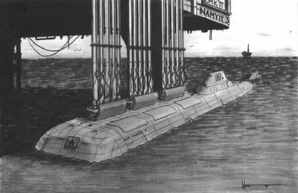
SovOil sub in the China Sea 2020
A great deal of SovOil's crude is pumped from offshore rigs in the shallow and mid-level depths of the Caspian and South China seas. The company maintains over 1000 offshore platforms, each capable of running up to thirty productive wells. About 600 of these platforms are in the South China Sea, and 300 are in the Caspian. Of the remaining 100, thirty are with the exploratory program in Antarctica, and the rest are in other exploratory sites scattered around the world.
SovOil's pumping platforms are sophisticated and efficient, but they are conventional in design. SovOil is more confident in the security of its offshore platforms than Petrochem, and it has not tried to implement radical programs like Petrochem's Submerged Drilling Project. The corporation views these operations as needlessly expensive, and prefers to place its Faith in a large, well-armed security force. SovOil does use fifteen submersible tankers, and, though they represent only a small part of its combined oil fleet, they are the most owned by any single corporation. Although SovOil's submersible and standard tankers can load oil at offshore and onshore terminals, and at several major platforms, the corporation does not have the technology to do underwater oil transfers in the manner of Petrochem's SDPRs. The corporation does have submerged tank farms around its offshore fields, and thousands of kilometers of submerged pipeline around the world.
SovOil has a large subsidiary devoted to the manufacture and maintenance of the offshore rigs and much of their support technology: Offshore Engineering, Inc. This industry and its subcontractors are responsible for the economic health of many of the fourteen republics. Combined, they employ several hundred thousand people.
Offshore Support Services[]
Over 150,000 people work on SovOil's offshore rigs. The large amounts of personnel and equipment demand constant support services, and SovOil has an entire division devoted to just that. Several huge 'flotels' service the offshore rigs. These are enormous, mobile platforms packed with recreational and service facilities for the crews and machines of the offshore rigs. Mobile fire-fighting and crisis platforms also patrol the fields, along with special naval vessels devoted to offshore security. On shore, shipyards and airports service the huge number of vessels that travel every day between the land and the offshore installations, and giant terminals and docks receive the oil arriving from pipelines and tankers. Special facilities house divers living under high pressure saturation for long periods of time, and huge recreational complexes serve off duty offshore workers, some of whom may not have sen land for several weeks.
Oil Transport[]
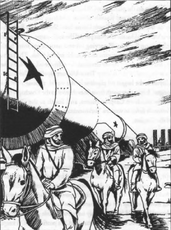
KazakhstanSovOil Pipe Transport
SovOils widespread pumping areas require a secure and well- developed oil transport industry capable of moving large quantities of crude under hostile conditions. The company's vital terrestrial and marine pipelines and huge fleet of tankers and support ships connect land and offshore oil fields to terminals and refineries.
One of the company's major concerns is shipping oil from off- shore fields to onshore terminals. The company has a huge fleet of surface tankers, but they are vulnerable to attack. Submersible tankers are secure, but move less product than surface vessels while being more expensive to buy and operate. Pipelines are efficient for both underwater and overland transport, but they are expensive to lay (underwater pipeline costs five million eb per mile) and easy to sabotage. However, since they offer the best means of transport, SovOil has invested a great deal in pipeline technology and construction. One of the company's major departments is devoted solely to the design, construction and management of major oil and gas pipelines.
Little has changed in overland pipeline design; the lines arc made of reinforced concrete, and usually not buried. SovOil uses a reinforced "bunker" design, where the pipeline is actually bored through the center of large concrete blocks rather than being a cylindrical tube. The lines also use three to five smaller bores rather than one or two large ones. This is expensive, but it helps protect against attack and rupture. The corporation also maintains a large, quick-response security force devoted solely to protecting the thousands of miles of overland pipeline and the critical pumping stations which regularly punctuate the lines.
The underwater pipelines have undergone a little evolution. They are still fashioned from concrete, as they have been for decades, but they use a special blend developed by SovOil. The blend has a proprietary, synthetic binding matrix that has some give, allowing the pipes and joints to flex more than regular concrete. This makes the pipelines more resistant to the seismic disturbances common in the volcanic active South China Sea. The blend is also lighter than regular concrete. This, along with the flexibility, enables the pipe to better withstand the common undersea cave- ins and shifts which can leave long spans unsupported. It also makes it possible for engineers to lay pipeline at greater depths and over larger chasms than they could with older technology. The lines are reinforced to stand up to sabotage and incidental hazards such as dragging anchors.
New cybernetic technology plays a part in modern oil pipelines. Once lines were cleaned by running 'pigs' (large scrubbing plugs propelled by oil pressure) through the bore. Now, cybernetically-controlled robots patrol the inside of the pipeline, scrubbing the bore and monitoring for developing leaks and structural cracks. Some robots can turn themselves into mobile plugs when necessary, using their bodies to seal ruptured pipes. Self-sealing systems repair small ruptures until technical teams can make long-term repairs.
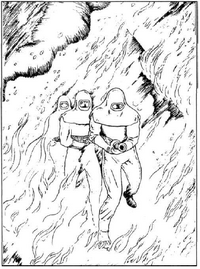
SovOil Troubleshooters
Other Important Elements[]
- Refining - SovOil sells unrefined crude oil to several nations and corporations, all of whom process the oil to meet their individual needs.
- Commercial Natural Gas - Natural Gas is a standard byproduct of oil drilling. SovOil is the world's largest producer of the light natural gasses methane, ethane, butane, propane, and pentane. These gasses are valuable products in 2020, and they are collected and sold by SovOil.
- Mining - SovOil has large coal mining operations through- out central and northern Siberia and in the western republics and the Balkans. The Soviet Union remains one of the few areas where coal is actively burned for heat and power.
- Industrial Troubleshooting - SovOil maintains crack squads of quick-response troubleshooters. These men and women are not soldiers, they are specially trained engineers, technicians, and roughnecks, prepared and equipped to deal with the kinds of catastrophes that can suddenly strike the oil and mining businesses.
- CHOOH2 - SovOil produces and sells about half the volume of CHOOH2 that its American rival does, but it has a strong share of the western European market, and a virtual lock on the fledgling Soviet market.
- Retailing Fuels - SovOil retails gasoline and other fossil fuel products in the Soviet Union, and CHOOH2 around the world. In the Soviet Union, the retail stops are called by the corporation's Russian nickname: KeroSov. In the rest of the world, they are called by the corporation's English/Western name: SovOil.
- Heavy Industry - SovOil needs a wide variety of specialized heavy equipment to run its oil, mining and CHOOH2 operations. Since SovOil and Petrochem are the only two corporations with large-scale oil operations, they must be almost entirely self-sufficient in designing and manufacturing this equipment.
- Power - Natural that SovOil branch out into commercial energy. The company acquired and renovated many of the Soviet Union's aging coal, oil, nuclear, and hydroelectric power plants, and built many of its own from scratch. SovOil now supplies electricity to most regions of the Soviet Union.
- Geological Exploration - SovOil has a sophisticated geological research and engineering department that searches the world looking for the telltale signs indicating valuable oil or mineral deposits.
- Military - SovOil has huge resources spread around the world. Many of these resources are critical, expensive, and fragile. It only takes one missile to completely destroy a multi-million eb offshore platform or to rupture an overland pipeline and spill millions of gallons of oil onto the tundra.
- SovOil Security Forces - SovOil's own army, commanded by General Lupold Korepino. The security force consists of an infantry branch and a Navy branch.
- SovOil Secret Police - a widely feared organization headed by Valentin Domanevka. They do not work together with the Security Forces, and often operate in a stealthy manner.
- SovOil Investments - an investment firm managing portfolios and investments around the world. It is headed by Neonila Novikovo, the daughter of SovOil founder Anatoly Novikovo.
Goals[]
SovOil is a wealthy and powerful corporation, with unmatched access to an incredibly valuable commodity, plus a variety of other products and industries. As long as the oil continues to flow, the corporation will thrive and grow. SovOil's leaders know, however, that the oil will not flow forever, and they are making plans that will carry the company into the next step of its evolution, when the oil is no longer a prime source of income.
The first step toward ensuring the company's survival is diversification. SovOil is the major economic force in the Soviet Union and much of eastern Europe, and the company has a guaranteed market share in these areas. The more services and goods the corporation can provide the people of these regions with, the better off the company will be when oil is no longer a mainstay. SovOil is already active in mining, construction, shipbuilding, vehicular design, electronics, research and CHOOH2 agriculture. It is just beginning to move into aircraft, computers, synthetics, CHOOH2 power systems, and general agriculture. By 2030, the board hopes to have a product base diverse enough to support the company after the oil is gone.
A major part of the company's post-oil fortunes will depend on how successful SovOil's CHOOH2 endeavors are. SovOil's directorate hopes that the company can begin to compete with Petrochem in terms of volume and quality within the next decade. SovOil is increasing its agricultural base, expanding its CHOOH2 plantations into Eastern Europe and the Mediterranean nations. The company continues to fund extensive research to improve the efficiency of its fermenting and refining technique, and the number of SovOil CHOOH2 stations and fuel supply contracts is growing daily.
SovOil's expansion in the CHOOH2 industry has not gone unnoticed by Petrochem. There is still a great deal of acrimony between the two corporations, even ten years after the war. With competition for the CHOOH2 market heating up, and world oil resources growing scarcer and more valuable, it looks like the two giants may be headed for another violent conhntation. Especially volatile hot spots include the Antarctic, where both corporations have ongoing oil exploration programs, and Western Europe and South America, where the corporations are trying to sell CHOOH2 to the same clients. Petrochem still smarts from its loss of the valuable South China Sea oil fields, and if another confrontation erupts it will no doubt commit every resource to make sure that it emerges on top. Military and stock analysts are keeping a careful watch on the situation. There is justified anxiety that, if another large conflict erupts, the world's supply of CHOOH2 and Hydrocarbon products will drop precipitously, and the entire corporate hierarchy will be destabilized.
Corporate Problems[]
SovOil's concerns extend beyond its diversification and competition with Petrochem. The corporation operates in a very politically unstable area. The Union of Soviet Sovereign Republics is a shaky alliance at best. Despite Central Committee government and nominal economic cooperation, many of the republics have their own agendas. Hostilities often erupt between republics with long histories of conflict, and bickering and dissent are common. If a political catastrophe was to cause the fragmentation of the USSR, many analysts believe that SovOil would not survive for long as a corporate entity.
In order to stabilize the area as much as possible, SovOil has become both overtly and covertly active in the governments of most of the republics and in the Central committee. The company lobbies publicly for continued alliance, and financially and politically supports pro-union politicians. Behind the scenes, SovOil's secret police actively work, via bribes, intimidation, and assassination, to make sure that the right people come to power and remain there. Although the new Union was envisioned as a self-perpetuating alliance, SovOil has become the primary force responsible for its economic and political stability.
Petrochem is aware of SovOil's precarious political situation, and the American corporation has an entire covert department devoted to destabilizing the USSR and interfering with SovOil's unification work. The Central Committee and the republican governments have become a huge battleground for Soviet and American corporate and political espionage agents. Although most analysts are expecting another battlefield conflict, it could be the war behind the scenes that determines which corporation will survive and which will fade.
Notable Employees[]
- Main article: List of SovOil employees
Key Facilitates[]
SovOil Headquarters[]
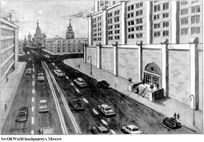
The SovOil World Headquarters is a sprawling, ten-story building on Shcherbinka Prospekt, near the center of Moscow. The building has been SovOil's headquarters ever since the corporation was a government agency, and it is showing its age. Although a new, modern headquarters tower is under construction on the outskirts of town, it will be two to three years before it is ready to enter service. Ironically, many of SovOil's recently constructed regional and international offices are much more modern than the dilapidated headquarters.
The headquarters building is a huge, squat affair, covering a large area. The building is made from stone and masonry, and is rather drab in appearance. The only clue to the identity of the owner is the legend "Soviet World Oil Industries" and the company logo etched in the glass of the main entrance doors. The building was originally erected in the 1970s to be government offices for the old Soviet Union, and it followed the undistinguished precedent established by over fifty years of unimaginative socialist construction. The building is, however, very sturdy. The masonry walls are thick, and the building can be made nearly impregnable, even in riots.
The headquarters building is enormous, covering an entire city block. It is square, with a spacious central courtyard. The building is as drab and utilitarian on the inside as on the outside. The only areas conceding anything to style or comfort are the lobby, the senior executive areas, and the guest apartments. There is little in the way of superfluous decor or adornment.
The Shevchenko Installation[]
This installation is the largest oil refinery in the world. It is a massive facility located at the junction of several major oil pipelines in the Caspian sea.
Flotels[]
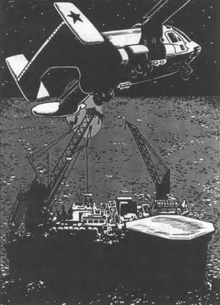
Although offshore platforms are well quipped, they can not be considered pleasant by any stretch of the imagination. The recreational facilities are cramped, and rapidly wear thin. Part of the problem is alleviated by flotels. These are huge, mobile rigs that float on enormous metal pontoons, and have crews of 100 to 200. There is usually one assigned to each field. The flotels can travel from rig to rig, and usually have regular aircraft service to and from each rig in their field. The flotels have expanded recreational, housing, and landing facilities, and are often the site of offshore conferences and social events. SovOil flotels have movie theaters, company brothels, bowling alleys, dance clubs, large libraries, and other diversions. They also have expanded maintenance facilities, and quick response troops that can be dispatched to any rig in the field. There is always at least one aircraft at each flotel.
Regional Offices[]
SovOil has regional offices throughout the world, although they are far more common in Europe and Asia than in the United States. The regional offices are all smaller than the main headquarters, but most are more modern and more tastefully designed and appointed. In many corporations, getting moved to the home office is considered a move upward. In SovOil, with its drab headquarters (and deplorable Moscow weather), a transfer to Tropical Asia or Western Europe is an often sought after reward. SovOil has major regional offices in St. Petersburg, Tashkent, Vladivostok, Tokyo, Seoul, Beijing, Hong Kong, Manila, Ho Chi Minh City, Bandar Seri Bagawan (Brunei), Kuala Lumpur, Singapore, Sydney, Nairobi, Algiers, Caracas, Rio De Janiero, Havana, Rosslyn/Washington, D.C., Night City, Druzhnaya (Antarctica), and virtually every capital city in Eastern and Western Europe. Minor offices span the world.
Resources & Stock[]
Based on the value of the assets and holdings of the corporation, rather than the value of the combined stock. Combined stock value would be the price to actually buy control of the corporation and its assets. A rough estimate of the complete takeover value of other corporations, multiply the number of common shares by the current price, and double the result. A 51% controlling share of the stock can be had for about 70% of the complete takeover price. Of course, most corporations strictly (and illegally) monitor the sale and ownership of major blocks of their stock. Virtually all make sure that a control- ling share is held by a group of loyal individuals who will not sell under any conditions.
Corporate Value[]
SovOil is currently worth 400 billion dollars, making it the seventh largest corporation in the C Magine's Index. SovOil's ranking is interesting, however, as the corporation has far fewer developed holdings and subsidiaries than many of the other top ten corporations. Most of SovOil's wealth comes from the abstract, projected value of its known and potential oil reserves. If SovOil was to suddenly be stripped of all of its oil holdings, its CHOOHZ, manufacturing, and other subsidiaries and proper- ties would amount to about 200 billion in gross worth.
The breakdown of SovOil's 400 billion eb value is as follows: 200 billion is oil reserves at projected prices; 80 billion is CHOOH2 holdings and sales, 25 billion is subsidiaries; 68 billion is real estate, manufacturing, military, and other durable holdings; 15 billion is investments, loans and cash reserves; 12 billion is miscellaneous holdings. SovOil's directors know that the value from the oil reserves will expire someday, so the income being generated From them is being directed into the expansion of the corporation's subsidiary, investment, and durable holdings. The company hopes to be worth at least 300 to 350 billion in those areas when the oil runs out.
Action Taken[]
SovOil is represented by 410 million shares of common stock. Prices have fluctuated as result of oil speculation and exploration, and the corporation's military situation, but the price generally centers around 1 18 eb per share, with annual fluctuations of 5 to 15eb. The general trend has been upward since the end of the Second Corporate War.
Of SovOil's controlling stock, 8% is held by the Novikovo family's SovOil Investments Inc., under the control of Neonila Novikovo. The other inner board members hold average shares of about 1 %, with individual holdings ranging from 2% to 5%. The inner board accounts for about 20% of the company's stock. The outer board of 100 individuals accounts for another 10%, with average holdings of .I%. Another 10% of the company's stock is held in trust by subsidiaries in cross-ownership programs.
The remaining 60% trades openly. SovOil keeps cash reserves available to buy up the 1 1% necessary to retain a controlling share under any circumstances. This protects the corporation against hostile takeover, or disruption by enemies.
Human Resources[]
SovOil employs about a million people, a great number for its size. SovOil can afford this number largely because labor is extremely cheap in the Soviet Union, even under the Eurobuck. Of SovOil's million employees, one hundred thousand are Infantry soldiers, fifty thousand are Infantry guards, one hundred thousand are Naval troops, and fifty thousand are special forces, spies, and Secret Police agents. One hundred and fifty thousand employees work offshore installations, one hundred and fifty thousand work terrestrial fields and pipelines, and fifty thousand have specialized technical jobs. The remainder work in factories, subsidiaries, and in offices around the world.
Material Resources[]
SovOil's hardware resources have never been accurately count- ed. The company probably owns more vehicles and ships than any other corporation on earth. It has fifteen submarine tankers, forty surface tankers and freighters of capital size, and hundreds of smaller freight, service, and naval vessels. The corporation also has thirty Tupolev Tu-80 transport aircraft (the Soviet counterpart to the American C-25). Additional resources include 1000 offshore platforms, twenty flotels and eighteen MSVs. Anything beyond these numbers, such as small aircraft and armored vehicles, is pure conjecture.
Subsidiaries[]
SovOil has fewer actual subsidiaries than many other large corpo- rations, although it has several divisions and subdivisions. The following are many of SovOil's (SMKP's) divisions and subsidiaries, under their Soviet Initials. Subdivisions are in parentheses. SMKP Oil (Offshore and Onshore); SMKP Oil Technologies; SMKP Pipeline Technologies; SMKP Shipping and Oil Transport Industries; SMKP CHOOH2 (T'hnology, Fermenting); KereSov Fuel Retailing; SMKP Heavy Industries (Steel, Shipbuilding, Construction); SMKP Power Utilities; Troubleshooters International; SMKP Heavy Industries; SMKP Mining Industries; SMKP Manufacturing; Schwann-Auerbach Engineering; SMKP Geological Services; SMKP Ballistics; SMKP Research and Development; SMKP Petroleum Refining; SMKP Petrochemical (Synthetics, Pharmaceuticals); SMKP Investments and Financial Services.
Products[]
2020[]
| Type | Products |
|---|---|
| Equipment | Bearskin Hat[5] |
| Ammunition | SovOil Ceramic Projectiles[6] |
2045[]
| Type | Products |
|---|---|
| Equipment | SovOil Lubricant[7] |
| Vehicles | SovOil Mi-60[8] |
Gallery[]
References[]
- ↑ PONDSMITH, M. Cyberpunk Version 3.0. 1st ed., R. Talsorian Games, 2005. (p.12)
- ↑ 2.0 2.1 2.2 MOSS, W. Corporation Report 2020 Volume 3. 1st ed., Berkeley, CA, R. Talsorian Games, 1992.
- ↑ Adrian Marc in ArtStation
- ↑ 4.0 4.1 4.2 PONDSMITH, M. Cyberpunk RED Corebook. 1st ed., Kenmore, WA, R. Talsorian Games, 2020.
- ↑ MOSS, W. Corporation Report 2020 Volume 3. 1st ed., Berkeley, CA, R. Talsorian Games, 1992. (p.72)
- ↑ MOSS, W. Corporation Report 2020 Volume 3. 1st ed., Berkeley, CA, R. Talsorian Games, 1992. (p.74)
- ↑ HUTT, J. et al. Black Chrome. Kenmore, WA, R. Talsorian Games, 2023. (p.56)
- ↑ GRAY, J. et al. Danger Gal Dossier. Kenmore, WA, R. Talsorian Games, 2023. (p.120)


